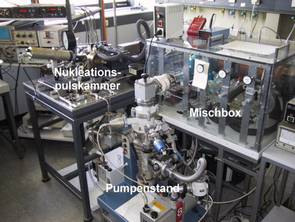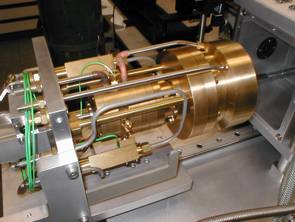Experimente zur Keimbildung
Kontakt: Dr. Judith Wölk
Bei der Beobachtung von Phasenübergängen gilt das Interesse der Keimbildung, sowie dem Wachstum und der Alterung der Keime. Die experimentelle Untersuchung der Keimbildung wird am Lehrstuhl von Prof. Dr. Strey mit Hilfe von selbstkonstruierten Nukleationspulskammern durchgeführt.
Wegen des Bezugs der Kondensationsexperimente zu atmosphärisch relevanten Systemen besteht hier ein großes Interesse an Experimenten unter Beteiligung von antropogenen und natürlich vorkommenden Substanzen. Hierzu wurde eine neue Mischtechnik entwickelt. Zur Zeit werden die Keimbildung von H2O und D2O [167, 168, 184], der 1-Alkohole [165], sowie Argon [238] untersucht. Die experimentelle Untersuchung der Argonkeimbildung erfolgt mit einer neukonstruierten Tieftemperatur-Nukleationspulskammer. Das Wachstum von Tröpfchen wurde an Wassertröpfchen [182, 183] und n-Pentanol untersucht. Neben der Untersuchung der Keimbildung in Nukleationspulskammern werden am National Institute of Standards Neutronenstreuexperimente an Aerosolen durchgeführt. Eine technisch relevante Frage ist die gezielte Beeinflussung der Blasenbildung in gasbeladenen Fluiden. Zur Weiterentwicklung der Keimbildungstheorie werden komplemetär zu konventionellen Experimenten Computersimulationen durchgeführt. An der Übertragung auf die Simulation für die industrielle Fertigung von Nanopartikeln wird gearbeitet.
Publikationen zum Thema:
[1] P.E. Wagner and R. Strey, Homogeneous nucleation rates of water vapor measured in a two-piston expansion chamber, J. Phys. Chem. 85 (18), 2694-2698 (1981).
[2] R. Strey and P.E. Wagner, Homogeneous Nucleation of 1-Pentanol in a Two-Piston Expansion Chamber for Different Carrier Gases, J. Phys. Chem. 86 (6), 1013-1015 (1982).
[3] P.E. Wagner and R. Strey, Measurements of homogeneous nucleation rates for n-nonane vapor using a two-piston expansion chamber, J. Chem. Phys. 80 (10), 5266-5275 (1984).
[4] R. Strey, T. Schmeling, and P.E. Wagner, The effect of the heat association on homogeneous nucleation rates in methanol vapor, J. Chem. Phys. 85 (10), 6192-6196 (1986).
[5] R. Strey, P.E. Wagner, and T. Schmeling, Homogenous nucleation rates for n-alcohol vapors measured in a two-piston expansion chamber, J. Chem. Phys. 84 (4), 2325-2335 (1986).
[6] R. Strey and Y. Viisanen, Measurement of the molecular content of binary nuclei. Use of the nucleation rate surface for ethanol-hexanol, J. Chem. Phys. 99 (6), 4693 (1993).
[7] Y. Viisanen, R. Strey, and H. Reiss, Homogeneous nucleation rates for water, J. Chem. Phys. 99 (6), 4680 (1993).
[8] R. Strey, P.E. Wagner, and Y. Viisanen, The Problem of Measuring Homogeneous Nucleation Rates and the Molecular Contents of Nuclei: Progress in the Form of Nucleation Pulse Measurements, J. Phys. Chem. 98, 7748-7758 (1994).
[9] Y. Viisanen and R. Strey, Homogeneous nucleation rates for n-butanol, J. Chem. Phys. 101 (9), 7835-7843 (1994).
[10] R. Strey, Y. Viisanen, and P.E. Wagner, Measurement of the molecular content of binary nuclei. III. Use of the nucleation rate surfaces for the water-n-alcohol series, J. Chem. Phys. 103 (10), 4333-4345 (1995).
[11] J. Hrubý, Y. Viisanen, and R. Strey, Homogeneous nucleation rates for n-pentanol in argon: Determination of the critical cluster size, J. Chem. Phys. 104 (13), 5181-5187 (1996).
[12] J. Wölk and R. Strey, Homogeneous Nucleation of H2O and D2O in Comparison: The Isotope Effect, J. Phys. Chem. B 105, 11683 (2001).
[13] P.E. Wagner and R. Strey, Two-Pathway Homogeneous Nucleation in Supersaturated Water-n-Nonane Vapor Mixtures, J. Phys. Chem. B 105, 11656-11661 (2001).
[14] J. Wölk, R. Strey, C.H. Heath, and B.E. Wyslouzil, Empirical function for homogeneous water nucleation rates, J. Chem. Phys. 117 (10), 4954-4960 (2002).
[15] K.A. Streletzky, Y. Zvinevich, B.E. Wyslouzil, and R. Strey, Controlling nucleation and growth of nanodroplets in supersonic nozzles, J. Chem. Phys. 116 (10), 4058-4070 (2002).
[16] A. Khan, C.H. Heath, U.M. Dieregsweiler, B.E. Wyslouzil, and R. Strey, Homogeneous nucleation rates for D2O in a supersonic Laval nozzle, J. Chem. Phys. 119 (6), 3138-3147 (2003).
[17] C.H. Heath, K.A. Streletzky, B.E. Wyslouzil, J. Wolk, and R. Strey, Small angle neutron scattering from D2O-H2O nanodroplets and binary nucleation rates in a supersonic nozzle, J. Chem. Phys. 118 (12), 5465-5473 (2003).
[18] A. Fladerer and R. Strey, Growth of homogeneously nucleated water droplets: a quantitative comparison of experiment and theory, Atmos. Res. 65 (3-4), 161-187 (2003).
[19] K. Iland, J. Wedekind, J. Wölk, P.E. Wagner, and R. Strey, Homongeneous Nucleation Rates of 1-pentanol, J. Chem. Phys. 121 (24), 12259-12264 (2004).
Allgemeine Literatur
[1] A. Laaksonen, V. Talanquer, and D.W. Oxtoby, Nucleation - Measurements, Theory, and Atmospheric Applications, Annu Rev Phys Chem 46, 489-524 (1995).


